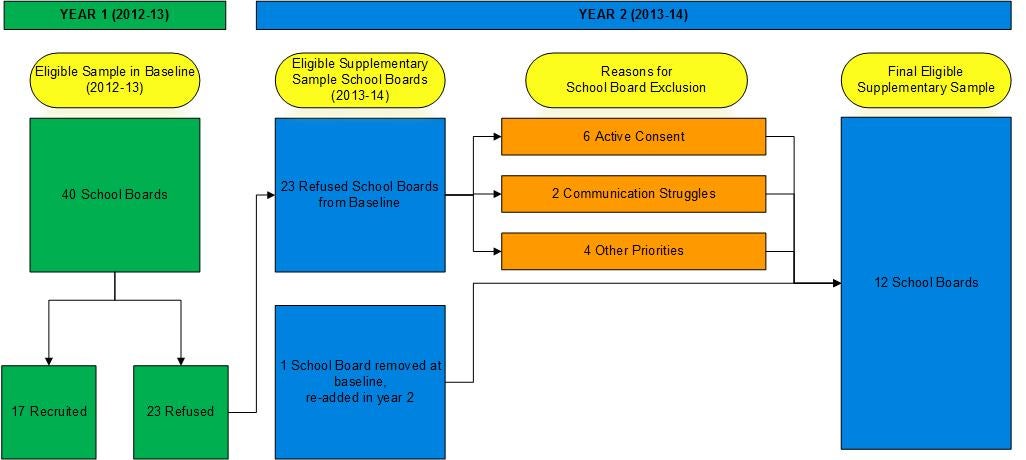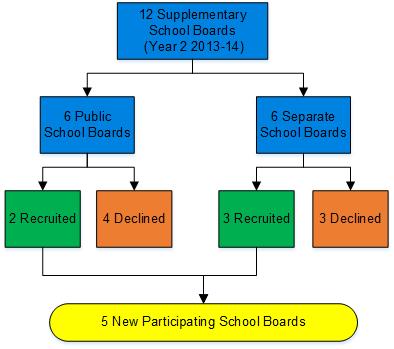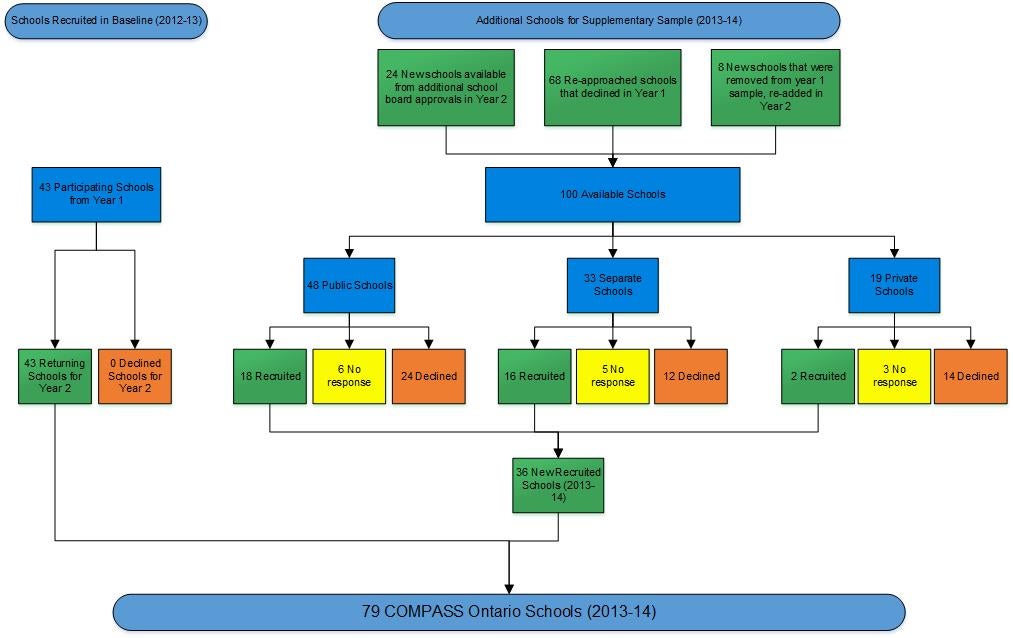Supplemental sampling and recruitment of additional schools in Ontario (PDF)
Compass technical report volume 3, issue 2, May 2015
Table of contents
Acknowledgements
Introduction
Determining target school boards and schools for the supplemental sample
school board and school recruitment
School board recruitment
School recruitment
Discussion
References
Acknowledgements
Authors
Chad Bredin, BA (Propel Centre for Population Health Impact, University of Waterloo, Waterloo, ON)
Audra Thompson-Haile, MA (Propel Centre for Population Health Impact, University of Waterloo, Waterloo, ON)
Scott T. Leatherdale, PhD (School of Public Health and Health Systems, University of Waterloo, Waterloo, ON)
Report funded by
The COMPASS study was supported by a bridge grant from the Canadian Institutes of Health Research (CIHR) Institute of Nutrition, Metabolism and Diabetes (INMD) through the “Obesity – Interventions to Prevent or Treat” priority funding awards (OOP-110788; grant awarded to S. Leatherdale) and an operating grant from the Canadian Institutes of Health Research (CIHR) Institute of Population and Public Health (IPPH) (MOP-114875; grant awarded to S. Leatherdale).
Suggested citation
Bredin, C, Thompson-Haile A, Leatherdale ST. Supplemental Sampling and Recruitment of Additional Schools in Ontario: Technical Report Series. 2015; 3(2). Waterloo, Ontario: University of Waterloo. Available at: www.compass.uwaterloo.ca.
Contact
COMPASS research team University of Waterloo 200 University Ave West, BMH 1038 Waterloo, ON Canada N2L 3G1 compass@uwaterloo.ca.
Introduction
COMPASS is a longitudinal study (started in 2012-13) designed to follow a cohort of grade 9 to 12 students attending a convenience sample of Ontario secondary schools for four years to understand how changes in school environment characteristics (policies, programs, built environment) are associated with changes in youth health behaviours [1]. COMPASS originated to provide school stakeholders with the evidence to guide and evaluate school-based interventions related to obesity, healthy eating, tobacco use, alcohol and marijuana use, physical activity, sedentary behaviour, school connectedness, bullying, and academic achievement. COMPASS has been designed to facilitate multiple large-scale school-based data collections and uses in-class whole-school sampling data collection methods consistent with previous research [2-5]. COMPASS also facilitates knowledge transfer and exchange by annually providing each participating school with a school-specific feedback report that highlights the school-specific prevalence for each outcome, comparisons to provincial and national norms or guidelines, and provides evidence-based suggestions for school-based interventions (programs and/or policies) designed to address the outcomes covered in the feedback report. (Refer to: www.compass.uwaterloo.ca).
As previously reported [5] baseline recruitment of schools (and thus student cohorts) was hampered by both labour strife (between public high school teachers and the Ontario government) and competing research (Youth Smoking Survey, Ontario Student Drug Use and Health Survey, etc.) in Ontario schools. We did not want to burden schools already participating in one project by asking them to participate in COMPASS as well. As a result of lower-than-anticipated recruitment rates in year 1, it was decided that COMPASS would attempt to increase the sample size in year 2 to achieve the original targets by adding a supplemental sample in Ontario and by adding an extra sample in Alberta. These supplemental samples would create a replenishment set of schools that would be followed for three years while the original cohort would still be followed for a total of four years.
This technical report will explain the process by which the supplemental Ontario sampling and recruitment was accomplished. For information regarding the sampling and recruitment for the original sample [6] and for the supplemental sampling and recruitment in Alberta [7], refer to www.compass.uwaterloo.ca.
Determining target school boards and schools for the supplemental sample
The original target sample for COMPASS was 80 schools. Baseline research, however only produced 43 schools. As such, the goal for year 2 of the study was to increase the sample size by an additional 37 schools. Ten schools were also added in Alberta in year 2 which created a target of 90 schools. During baseline recruitment (2012-13), the COMPASS staff recorded all reasons that school boards and schools declined to participate in the COMPASS project. These recorded reasons proved invaluable as the COMPASS study does not require a provincially-representative sample and thus past decline reasons gave the team insight into which boards and schools to purposefully target in the 2013-14 school year.
All school boards from the original sampling frame were initially considered to be a part of the supplemental sample. Forty boards were available in baseline. Of these 40 school boards, 17 were initially recruited, leaving 23 un-recruited boards available for year 2. At baseline, there was also one school board that was not approached to participate because the board only had one school that met the COMPASS two sampling criteria, and that school was already sampled for the Youth Smoking Survey (YSS). This school board was added to the year 2 sample leaving 24 boards open for recruitment. Details on the initial sampling frame have been published elsewhere [1, 6].
As previously mentioned, the COMPASS team recorded reasons of refusal when possible. Therefore our first step was to examine these reasons and eliminate any of the 24 school boards where participation in year 2 was unlikely. Six of the school boards were removed as it was learned during last year’s recruitment that these boards required active consent procedures. For reasons previously discussed [6,9,10] active consent is not appropriate for the COMPASS study. Two boards were removed from the sample because of communication struggles. These boards were approached to participate in baseline, and despite numerous attempts to solidify an answer, the COMPASS team never received any form of communication back. Lastly, four school boards were removed as communications in year one showed a limited interest or priority for COMPASS. It was decided that these boards would be removed from the supplementary sample so that the COMPASS recruitment coordinator could focus efforts on boards and schools more likely to respond and participate. Twelve school boards were approached to participate in year 2, which would potentially provide the COMPASS team with 70 additional schools.

Figure 1 for supplementary school board sampling details.
School board and school recruitment
School board recruitment
School boards that were recruited in baseline were not re-approached in year 2 as the initial application requested permission to contact schools for four consecutive years. School boards in the supplementary sample were contacted again for year 2 between March and September 2013. Boards were either sent a full recruitment package or were asked via phone or email if they would be able to reconsider participation this year. The contact method was determined using the contact notes with each individual school board from the previous year. For example, if the contact person at the board had not changed since year one and the board declined to participate but said they would consider next year, the COMPASS recruitment coordinator contacted the board member directly to ask them to participate and sent them more information/recruitment package if needed. This method of recruitment was used when a relationship had already been established between the recruitment coordinator and the contact at the school board. If the board member had changed, or the contact was unfamiliar with COMPASS, the board was couriered the general application package. More details on board recruitment methods can be found elsewhere [5]. Among the 12 (six public, six separate) new school boards approached, five (two public, three separate) agreed to participate. See figure 2 for supplementary school board recruitment results. Declining school boards did not participate because of competing research, they were over researched, no reason or were too busy.

Figure 2 Supplementary school board recruitment results (2013-14)
School recruitment
Newly recruited school boards gave the COMPASS team access to approach 24 new schools. Sixty-eight schools that had refused to participate or did not respond in year 1 were also approached again for year 2. Lastly, eight schools that were not included in the original sample in year 1 (because they were a part of the YSS sample (n=6), the school was re-building/not open (n=1) and lastly, a public health unit asked the COMPASS team to include an additional school in the sample so that they would have all of the schools in their jurisdiction participating in COMPASS), were re-added to the school sample in year 2. These additions resulted in 100 schools (48 public, 33 separate, 19 private) being available for recruitment in year 2. See figure 3 supplementary school sampling and recruitment results.

Figure 3 supplementary school sampling and recruitment results.
Returning schools
Schools from baseline (2012-13) that had already participated in year 1 of data collection were contacted via phone or email in September 2013 to book their COMPASS survey date for year 2 of data collection. The COMPASS recruitment coordinator encouraged year 2 school contacts to choose a survey date that was at the same time of year as when they initially participated. For example, if they participated in the spring term in year 1, it was suggested that they participate in the spring again to ensure that there was roughly a year between data collections. These guidelines were flexible when needed. All 43 participating year 1 schools were re-recruited for year 2 participation.
New Schools
All new schools were sent a standard recruitment package in September, 2013. The recruitment coordinator then contacted schools directly via phone or email to inquire about participating in the COMPASS study. Full details on recruitment methods have been published elsewhere [1, 8]. Among the 44 public schools approached, 18 agreed to participate, 24 declined and six provided no response. Among the 37 of separate schools approached, 16 agreed to participate, 12 declined and 5 provided no response. For the 19 private schools, two agreed to participate, 14 declined and three provided no response. This resulted in 36 new schools being added to the sample in year 2 creating a total of 79 participating COMPASS schools in Ontario.
Similar to the board recruitment procedures, during the school recruitment procedures, we provided schools that declined to participate with the opportunity to provide one or more reasons for their refusal decision if they felt so inclined. Among the schools that provided one or more reasons for their refusal, the most common responses were that the school was “too busy” or that “they were already involved in competing research.”
Discussion
As previously mentioned, in year one of COMPASS we were only able to recruit 43 schools to participate, which was less than half of our original target of 90 schools. As predicted, recruitment rates in year 1 were hindered because of Bill 115. This was brought to fruition as we were able to recruit an additional 36 schools in year 2 of COMPASS when teacher labour issues related to the Bill were no longer an issue. School boards and school principals no longer felt hesitant to ask teachers to administer the survey and ultimately felt that COMPASS was a worthwhile pursuit. It is also likely that recruitment numbers increased in year 2 as competing research such as YSS and OSDUHS were no longer in the field. Recruiting more schools in Ontario in year 2 not only increased our sample size, but also showed that boards and schools saw the importance of the COMPASS project as both board and school contacts that declined to participate in year 1 were eager to participate in year 2 when teacher labour issues were no longer present. The value of participating in COMPASS was also reflected in the fact that all of the original 43 recruited schools participated in year 2 of data collection. While the team had planned for 10% attrition rate at the school level each year (because of administrative changes, board and school priority changes), sound recruitment procedures, data collection methods, communication skills and the feedback received at the school level proved that schools value the COMPASS project. This point has been reflected through administrators and public health units. For example, one school principal at a year 1 COMPASS school switched schools in year 2 to a school that had had originally declined to participate in COMPASS. He felt that the data received at the school level was valuable for planning and programming and contacted the COMPASS recruitment coordinator to inquire about getting his new school on board. Similarly, a public six health unit inquired about adding an additional school from their jurisdiction to the sample in hopes of receiving data from all of the schools within their jurisdiction. This school had initially been omitted from the sample because student enrolment numbers were slightly lower than our sampling frame, however the COMPASS team added the school to the sample to aid the health unit in gathering data from their region to inform them of local youth health priorities.
While Ontario’s Bill 115 and competing research did cause recruitment disparities for the COMPASS team in year 1, it allowed the team to consider other options to increase sample size and the value of the study while still maintaining COMPASS’ research mandate. Expanding out of province in year 2 was another way we increased our sample size while also increasing the advantage of examining cross provincial differences among schools and students. While the original plan had been to recruit all schools in year one of data collection, COMPASS provides the valuable lesson that real world situations may cause plans to derail, but sound research like COMPASS will allow for improved options to arise.
References
1. Leatherdale, S.T., Brown, K.S., Carson, V., Childs, R.A., Dubin, J.A., Elliott, S.J., Faulkner, G., Hammond, D., Manske, S., Sabiston, C.M., Laxer, R.E., Bredin, C. & Thompson-Haile, A. The COMPASS study: a longitudinal hierarchical research platform for evaluating natural experiments related to changes in school-level programs, policies and built environment resources. BMC Public Health 2014, 14:331.
2. Leatherdale ST, Burkhalter R: The substance use profile of Canadian youth: exploring the prevalence of alcohol, drug and tobacco use by gender and grade. Addict Behav 2012, 37:318-322.
3. Leatherdale ST, Manske S, Faulkner G, Arbour K, Bredin C: A multi-level examination of school programs, policies and resources associated with physical activity among elementary school youth in the PLAY-ON study. Int J Behav Nutr Phys Act 2010, 25;6. doi: 10.1186/1479-5868-7-6.
4. Leatherdale ST, McDonald PW, Cameron R, Brown KS: A multi-level analysis examining the relationship between social influences for smoking and smoking onset. Am J Health Behav 2005, 29:520-530.
5. Leatherdale ST, Papadakis S: A multi-level examination of the association between older social models in the school environment and overweight and obesity among younger students. J Youth Adolesc 2011, 40:361-372.
6. Thompson-Haile A, Leatherdale, ST. Baseline Sampling and Recruitment Results. COMPASS Technical Report Series. 2013; 1(4). Waterloo, Ontario: University of Waterloo. Available at: www.compass.uwaterloo.ca.
7. Wagner M, Bredin C, Thompson-Haile, A & Leatherdale ST. Alberta Baseline Sampling and Recruitment Results. COMPASS Technical Report Series. 2015; 3(1).Waterloo, Ontario: University of Waterloo.
8. Thompson-Haile A, Leatherdale ST. School Board and School Recruitment Procedures. COMPASS Technical Report Series. 2013;1(3). Waterloo, Ontario: University of Waterloo. Available at: www.compass.uwaterloo.ca.
9. Hollmann CM, McNamara JR. Considerations in the use of active and passive parental consent procedures. J Psych Interdisc Appl 1999, 133, 141-156.
10. White VM, Hill DJ, Effendi Y. How does active parental consent influence the findings of drug-use surveys in schools? Eval Rev 2004, 28, 246-260.